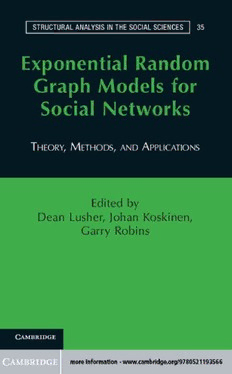Table Of ContentExponentialRandomGraphModelsforSocialNetworks
Exponential random graph models (ERGMs) are increasingly applied to
observednetworkdataandarecentraltounderstandingsocialstructureand
networkprocesses.Thechaptersinthiseditedvolumeprovidethetheoretical
andmethodologicalunderpinningsofERGMs,includingmodelsforunivari-
ate,multivariate,bipartite,longitudinal,andsocialinfluence–typeERGMs.
Each method is applied in individual case studies illustrating how social
science theories may be examined empirically using ERGMs. The authors
supplythereaderwithsufficientdetailtospecifyERGMs,fitthemtodata
withanyoftheavailablesoftwarepackages,andinterprettheresults.
Dr.DeanLusherisLecturerinSociologyatSwinburneUniversityofTech-
nology.Heworkscloselywithleadingmethodologiststodevelopanintuitive
understandingofexponentialgraphmodels,howtheylinktobroadernet-
worktheory,andhowtofitthemtoreal-lifedata.Hisresearchapplications
aredirectedatissuesofsocialnormsandsocialhierarchies.
Dr. Johan Koskinen is Lecturer in Social Statistics at the University of
Manchester. He is a statistician working with modeling and inference for
Social Science data. Focusing on social network data, Dr. Koskinen deals
withgenerativemodelsfordifferenttypesofstructures,suchaslongitudi-
nal network data, networks nested in multilevel structures, and multilevel
networksclassifiedbyaffiliations.
GarryRobinsisProfessorintheSchoolofPsychologicalSciencesattheUni-
versityofMelbourne.Robinsisamathematicalpsychologistwhoseresearch
dealswithquantitativeandstatisticalmodelsforsocialandrelationalsys-
tems. His research has won international awards from the Psychometric
Society,theAmericanPsychologicalAssociation,andtheInternationalNet-
workforSocialNetworkAnalysis.
StructuralAnalysisintheSocialSciences
MarkGranovetter,Editor
The series Structural Analysis in the Social Sciences presents studies that ana-
lyzesocialbehaviorandinstitutionsbyreferencetorelationsamongsuchcon-
crete social entities as persons, organizations, and nations. Relational analysis
contrasts with both reductionist methodological individualism and macrolevel
determinism,whetherbasedontechnology,materialconditions,economiccon-
flict, adaptive evolution, or functional imperatives. In this more intellectually
flexible structural middle ground, analysts situate actors and their relations in
avarietyofcontexts.Sincetheseriesbeganin1987,itsauthorshavevariously
focusedonsmallgroups,history,culture,politics,kinship,aesthetics,economics,
andcomplexorganizations,creativelytheorizinghowtheseshape,andinturn
are shaped by, social relations. Their style and methods have ranged widely,
fromintense,long-termethnographicobservationtohighlyabstractmathemat-
icalmodels.Theirdisciplinaryaffiliationshaveincludedhistory,anthropology,
sociology,politicalscience,business,economics,mathematics,andcomputersci-
ence.Somehavemadeexplicituseofsocialnetworkanalysis,includingmany
ofthecutting-edgeandstandardworksofthatapproach,whereasothershave
keptformalanalysisinthebackgroundandused“networks”asafruitfulorient-
ingmetaphor.Allhaveincommonasophisticatedandrevealingapproachthat
forcefullyilluminatesourcomplexsocialworld.
OtherBooksintheSeries
1. MarkS.MizruchiandMichaelSchwartz,eds.,IntercorporateRelations:
TheStructuralAnalysisofBusiness
2. BarryWellmannandS.D.Berkowitz,eds.,SocialStructures:ANetwork
Approach
3. RonaldL.Brieger,ed.,SocialMobilityandSocialStructure
4. DavidKnoke,PoliticalNetworks:TheStructuralPerspective
5. JohnL.Campbell,J.RogersHollingsworth,andLeonN.Lindberg,eds.,
GovernanceoftheAmericanEconomy
6. KyriakosM.Kontopoulos,TheLogicsofSocialStructure
7. PhilippaPattison,AlgebraicModelsforSocialStructure
8. StanleyWassermanandKatherineFaust,SocialNetworkAnalysis:
MethodsandApplications
9. GaryHerrigel,IndustrialConstructions:TheSourcesofGermanIndustrial
Power
10. PhilippeBourgois,InSearchofRespect:SellingCrackinElBarrio
11. PerHageandFrankHarary,IslandNetworks:Communication,Kinship,
andClassificationStructuresinOceana
12. ThomasSchweitzerandDouglasR.White,eds.,Kinship,Networks,and
Exchange
13. NoahE.Friedkin,AStructuralTheoryofSocialInfluence
14. DavidWank,CommodifyingCommunism:Business,Trust,andPoliticsin
aChineseCity
Continuedaftertheindex
Exponential Random Graph
Models for Social Networks
Theory, Methods, and Applications
Editors
DEAN LUSHER
JOHAN KOSKINEN
GARRY ROBINS
cambridgeuniversitypress
Cambridge,NewYork,Melbourne,Madrid,CapeTown,
Singapore,Sa˜oPaulo,Delhi,MexicoCity
CambridgeUniversityPress
32AvenueoftheAmericas,NewYork,NY10013–2473,USA
www.cambridge.org
Informationonthistitle:www.cambridge.org/9780521141383
(cid:2)C CambridgeUniversityPress2013
Thispublicationisincopyright.Subjecttostatutoryexception
andtotheprovisionsofrelevantcollectivelicensingagreements,
noreproductionofanypartmaytakeplacewithoutthewritten
permissionofCambridgeUniversityPress.
Firstpublished2013
PrintedintheUnitedStatesofAmerica
AcatalogrecordforthispublicationisavailablefromtheBritishLibrary.
LibraryofCongressCataloginginPublicationData
Exponentialrandomgraphmodelsforsocialnetworks:theory,methods,and
applications/[editedby]DeanLusher,SwinburneUniversityofTechnology,
JohanKoskinen,UniversityofManchester,GarryRobins,Universityof
Melbourne,Australia.
pages cm.–(Structuralanalysisinthesocialsciences;35)
Includesbibliographicalreferencesandindex.
ISBN978-0-521-19356-6(hardback)–ISBN978-0-521-14138-3
(paperback) 1.Socialnetworks–Mathematicalmodels. 2.Socialnetworks–
Research–Graphicmethods. I.Lusher,Dean,editorofcompilation.
II.Koskinen,Johan,editorofcompilation. III.Robins,Garry,editorof
compilation.
HM741.E96 2012
302.3–dc23 2012021034
ISBN978-0-521-19356-6Hardback
ISBN978-0-521-14138-3Paperback
CambridgeUniversityPresshasnoresponsibilityforthepersistenceoraccuracy
ofURLsforexternalorthird-partyInternetWebsitesreferredtointhis
publicationanddoesnotguaranteethatanycontentonsuchWebsitesis,or
willremain,accurateorappropriate.
For
Jo,Massimo,andPriscilla
Pirkko
Jane,andOlivia
THANKS
Wethankourchaptercontributorsfortheirknowledge,
dedication,andpatienceinproducingthisbook.Thanksalso
toourcolleaguesintheMelnetsocialnetworkgroupand
elsewherewhohavecollaboratedwithusandprovided
adviceinourresearchonexponentialrandomgraphmodels.
Additionally,weareindebtedtoMelNetSNAcourse
participantswhosequestionsandinquisitivenesshave
directedthecontentofthiseditedvolume.Wearegratefulto
colleaguesattheDefenceScienceandTechnology
Organization(DSTO)inAustralia,andNuffieldCollegeand
theMitchellCenterintheUKforvaluablecommentsand
feedback.Inparticular,thankstoNectariosKontoleon,Jon
Fahlander,andBernieHoganforcommentsonselected
partsofthebook.Finally,thankyoutoSarahCraigand
ClaudiaMollidorforpreparingthebookforpublication.

